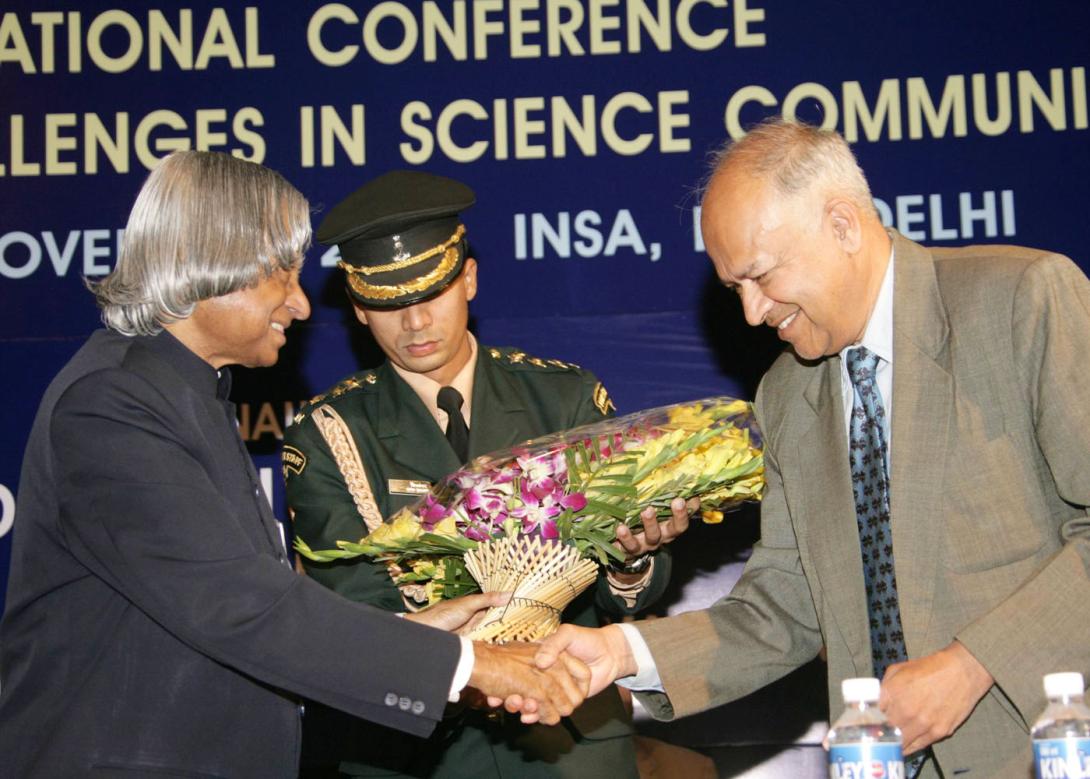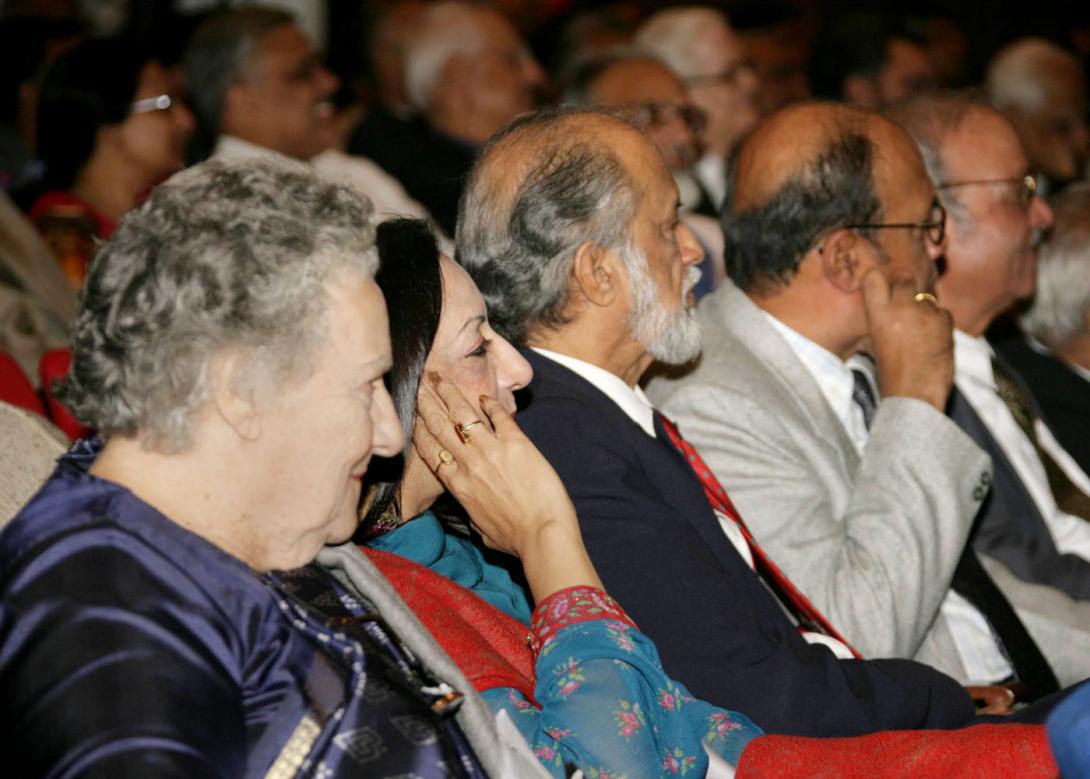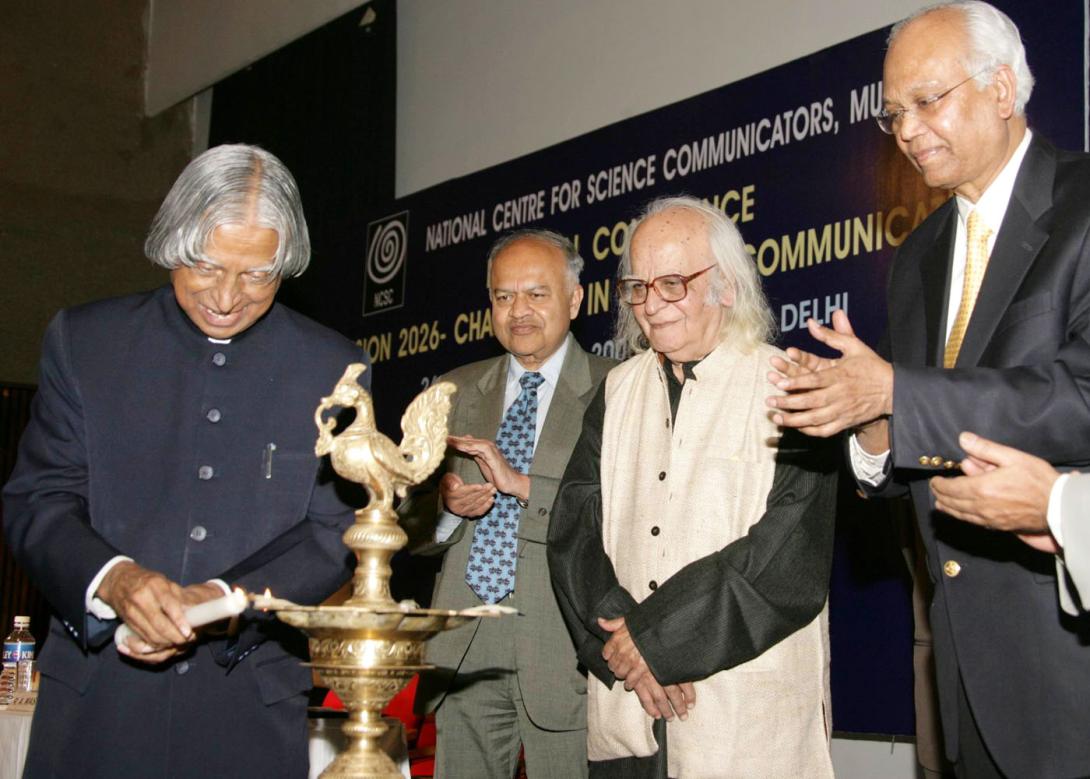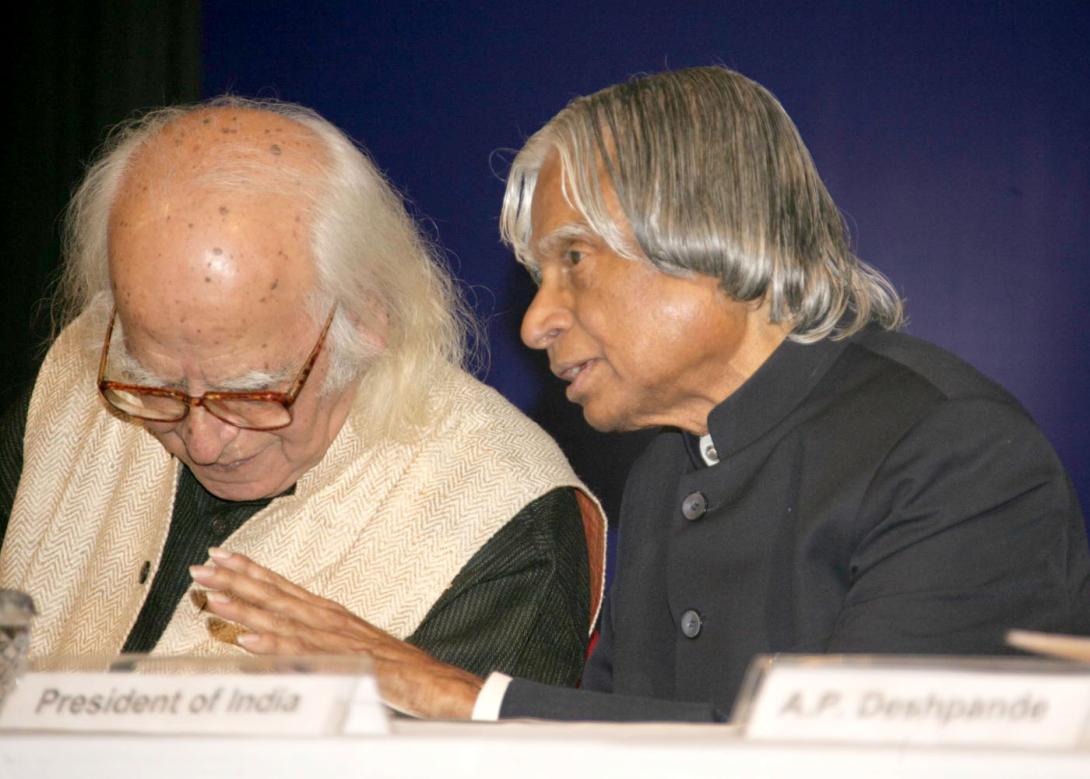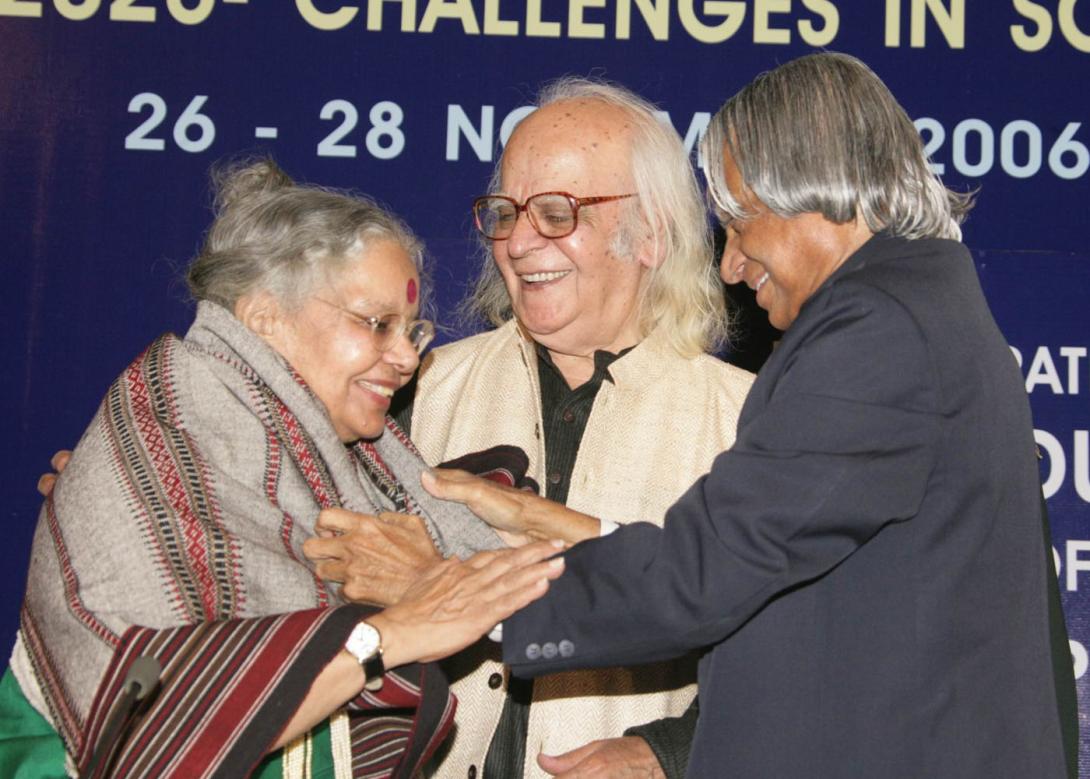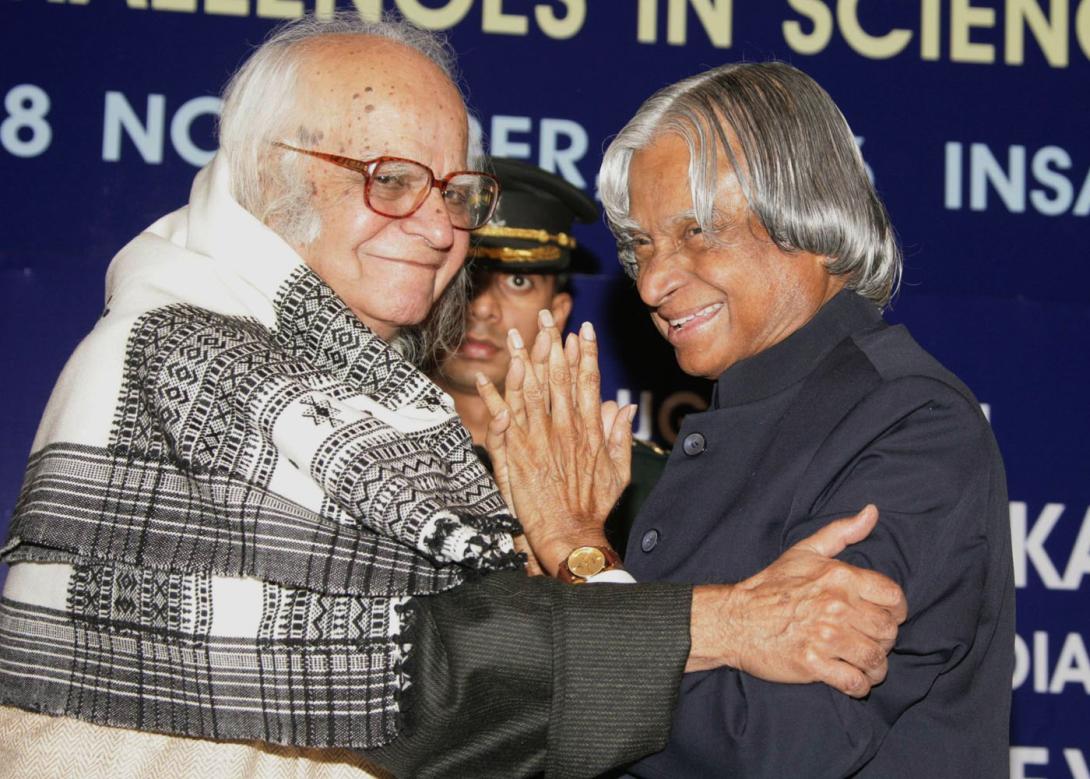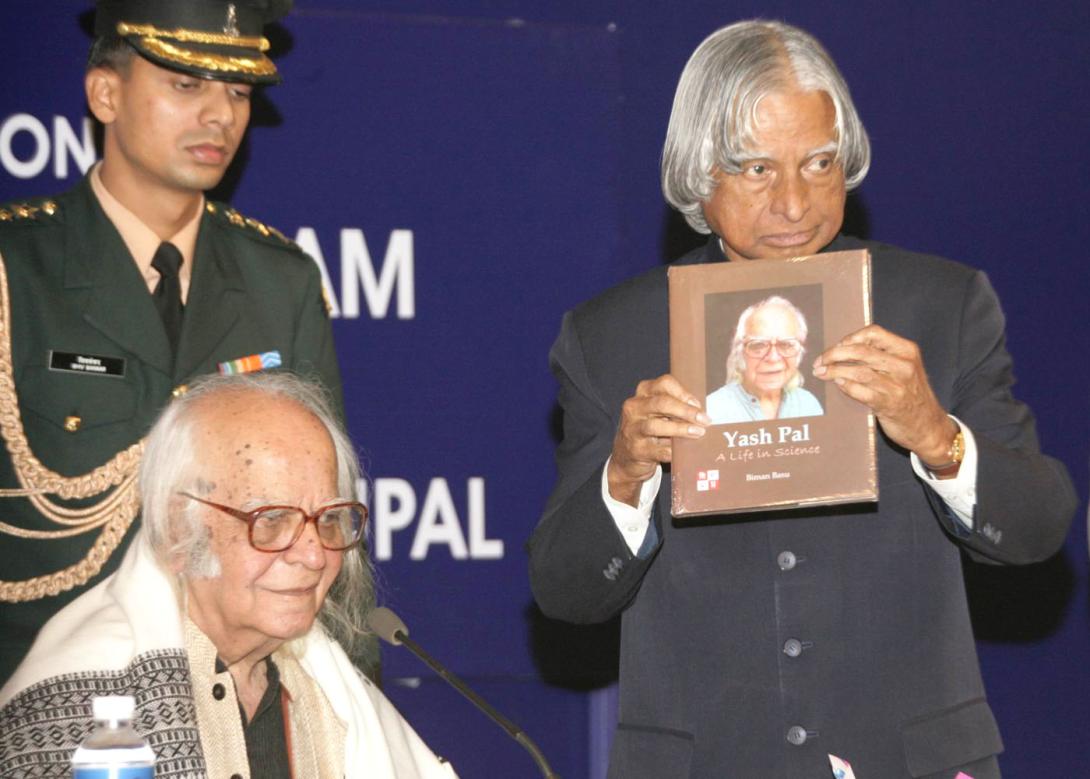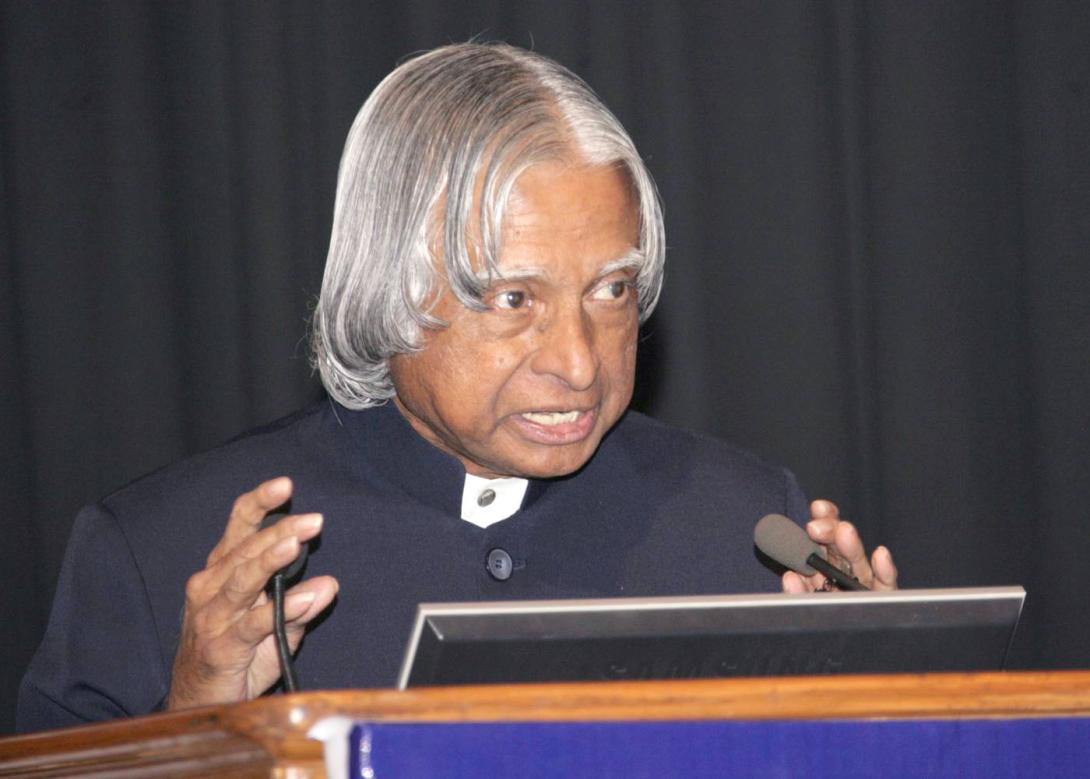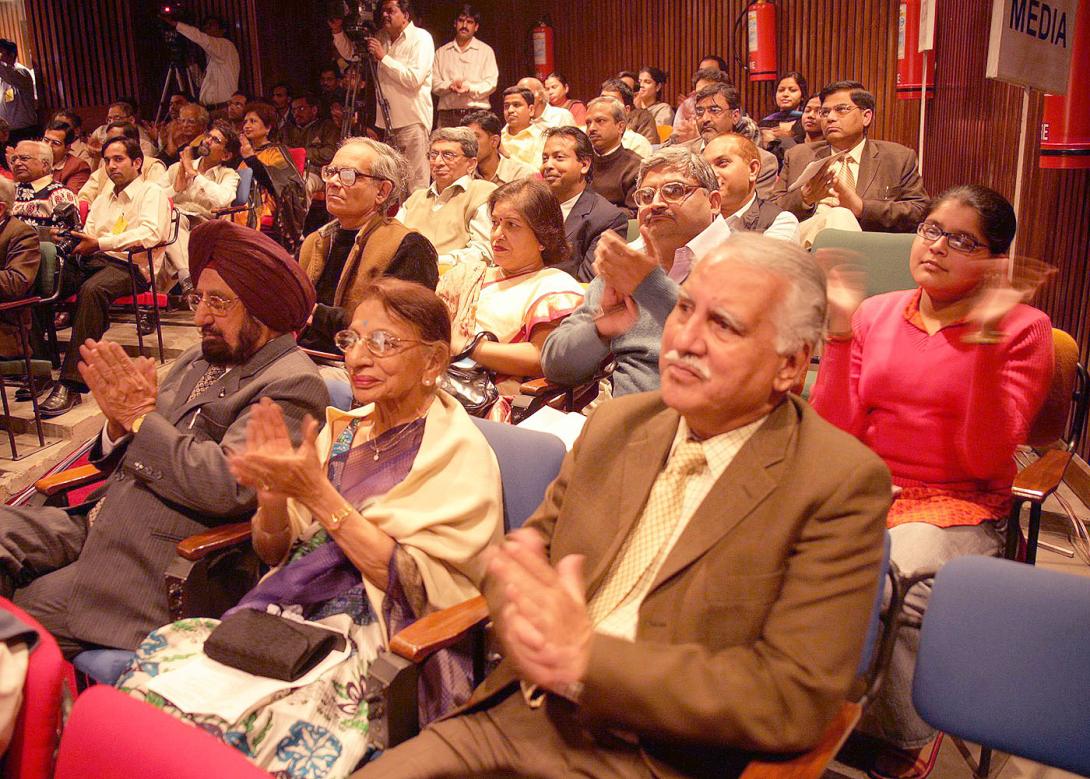Address at the Inauguration of the National Conference on Vision 2026-challenges in Science Communication
New Delhi : 26-11-2006
Science is a life time mission
I am delighted to participate in the inauguration of the National Conference on Vision 2026 ? Challenges in Science Communication organized by National Centre for Science Communication on the occasion of the 81st birthday of Prof Yash Pal, a renowned scientist, educationist and science communicator. Congratulations to Prof. Yash Pal. My greetings to the Chairman and members of National Centre for Science Communication, scientists, technologists, researchers, science communicators, students and distinguished guests. When I am with you I would like to talk on the topic ?Science is a life time mission?.
Prof. Yash Pal and Science
Prof Yash Pal has done substantial contribution to Indian science, science applications and science propagation. Whenever I see Prof. Yash Pal, I always see in front of me three events. The first one I remember is, when I was working with space scientists, periodically Prof. Yash Pal used to visit TERLS, and give beautiful suggestions to protect the delicate payloads from the shock generated by the rocket during take off and the flight sequence. The suggestions were useful and I used to telephone to him, how his suggestions totally worked during the integration of the sounding rocket payloads and flight. The second event took place in 1980, when I was busy with SLV3 launch at Sriharikota. Prof. Yash Pal was busy in setting up the Kytonn experiment, which is a tethered balloon for communication medium platforms. It had many technological innovations. This thought at that time was very new, today in many parts of the world; it has become an operational system, particularly in the defence sector and hilly regions. The third event was, when Prof. Yash Pal saw my team working in multiple tasks and suggested that I must build a chicken-mesh antenna for the SITE experiment. This development should compete with two more engineering groups in the country. He gave stringent specifications and demanded that the antenna should be very cost effective, and should be built and delivered within three months time. It was done. This chicken mesh antenna was intended to receive the educational programme broadcasted through the communication satellite for remote villages in India.
When he was Director in Space Application Centre, later Secretary General for UNISPACE and the Chairman UGC and whatever task that he undertook, his mission was to empower the children and the youth, particularly the rural village folk with proper education and skill. NCERT has prepared the National Curriculum framework under Prof. Yash Pal?s leadership and modified the CBSE syllabus for promoting creative education at all levels through the application of learning by doing concept. He is the most sought person in children science congress, and the children seek answers from him in large numbers. He has a unique way of answering the questions of the children by constantly interacting with them and making them understand the answer through the discussion process itself. It is a beautiful scene to watch. Eighty years what does it means? Prof. Yash Pal indeed today, after completing eighty orbits around the sun, is entering into the eighty first orbit, and many and many more orbits to come. The eighty beautiful years, with his cheerful family is indeed God?s blessing and I wish him and his family all the best on this occasion.
Human evolution and Progress
Life originated in this globe 600 million years ago and continental drift occurred 200 million years ago making our one land into five continents. Mammals evolved 140 million years ago, Hominid (human type) evolved 26 million years ago but the modern man only some 200,000 years ago. That too he emigrated and colonized the rest of the world only since 50,000 years. Spoken language was some 10,000 years old while written only a few thousand years old. All the phenomenal progress of Man was thus only within this short span of 400 -200 generations (i.e., 10,000 -5,000 years). With the evolution of human being, many advances in science and technology have been made by him for progressively improving the quality of life. At the same time, from the origin until now, society has always been at war within and between groups and has generated two world wars. Recently, two more wars had also been triggered. Presently, terrorism and low intensity warfare are affecting many parts of the world. What can be the solution? Leveling the societal standing and bridging the economic disparities among people and among nations is the real challenge. Can science and technology give a solution for the planet to live peacefully; it is a big challenge for the human beings.
Science and Technology is continuously being applied for improving the quality of life of people in the society, particularly during the last 200 years. For example, the revolution in increasing the life expectancy, creating a disease free world in the midst of diseases, agricultural revolution, and electronic revolution in making the world borderless and many more applications. Why not the same science and technology promote economic prosperity by leveling the standing between nations and among societies? Apart from political visionaries, scientist, technologists and economists, the science communicators can become a partner in the mission of promoting a peaceful and prosperous planet earth.
Building the Sprit ?I can do it?
Between the age of 14 and 17, it is very important to inject the beauty of science, challenge of science and bliss of science among the students. As per one of our renowned scientists ?The working in science itself is the greatest award a scientist can dream of?. In this connection, I would like to recall one of the important questions answered by Prof. Yash Pal, which reflects this thought. In his book on ?Discovered Questions?, I found an interesting answer, giving hope to the young for the question ?What does it take to be the Nobel prize winner??. He says, ?Nobel prize winners are not demigods. But usually they are rather creative people. They are also those who have dared to think thoughts that were not very conventional or fashionable and they are astonishingly hard working. Work for most of them is not arduous or unpleasant. It is something they just cannot help doing. They often are prisoners of great passion. Though some lobbying might help, usually it is superfluous, even counter productive. Your work must be exposed to the scrutiny of your peers. You cannot get a Nobel prize for doing something great and not telling anyone about it.? - what a great message for the young scientist of India. This message will definitely give the confidence to the Indian scientist that ?I can do it?. Now, I would like to discuss the special importance given by Nobel laureate Sir C.V. Raman for the work of his research student.
Value of Science
Recently I was reading the two volumes of the book titled ?The Big and the Small? from the Microcosm to the Macrocosm written by Dr. G. Venkataraman. In this latest book, author establishes fascinating link between particle physics and cosmology in two volumes. Since I am in the midst of Scientists and Technologists, I thought of sharing with you an incident narrated in the book about Sir CV Raman. Raman was Bharat Ratna Award winner in the year 1954. The award ceremony was to take place in the last week of January, soon after the Republic Day celebrations of 1954. The then President Dr. Rajendra Prasad wrote to Raman inviting him to be the personal guest in the Rashtrapati Bhavan, when Raman came to Delhi for the award ceremony. He wrote a polite letter, regretting his inability to go. Raman had a noble reason for his inability to attend the investiture ceremony. He explained to the President that he was guiding a Ph.D. student and that thesis was positively due by the last day of January. The student was valiantly trying to wrap it all up and Raman felt, he had to be by the side of the research student, see that the thesis was finished, sign the thesis as the guide and then have it submitted. Here was a scientist who gave up the pomp of a glittering ceremony associated with the highest honour, because he felt that his duty required him to be by the side of the student. It is this value system that truly builds science.
Science communication past, present and future
In the early days due to evolution of science, the science communication presented challenges due to poor literacy and general knowledge levels of receptors and the absence of multiple medium of communication. Today thanks to the efforts of science communicators like Prof Yash Pal, I am seeing signs of science penetrating the socio-culturally diverse society of our country touching every facet of day-to-day life. The scientists and science communicators have grown in number over the years. There have been initiatives from Government, NGOs and individuals in a broad spectrum of activities like popularizing science, training courses, lectures, fellowships and recognition of good works. Particularly, the programme titled ?A Journey through the World of Science - Turning Point? conducted by Prof Yash Pal and his team in the Doordarshan Channel really kindled the imagination of the youth in the 1990s. Outreach has expanded substantially through diverse media like print, audio-visual, folk, interactive and digital including CD and internet. I myself have addressed few annual Children Science Congresses, a highlight in the science communication calendar. The National Council of Museums, Kolkata is coordinating 21 science museums. And also there are five science cities in the country. Indian science communicators have used various modes of communication to reach out. The communication, information, digital, video technologies have expanded tremendously. The TV and global communication provide opportunities in a way unprecedented to the people both literate and otherwise to learn the contemporary developments in science and technology and their applications.
The future challenges of science communication have several dimensions. The value of science has to be propagated to people at large and they should be made to realize the role played by science in their day to day life. Young should be motivated to study and enquire into science. The innate fear that ?science is a difficult subject? should be removed from the minds of the children through easy to understand, interesting, creative presentations by the science communicators. Research, discoveries and development in one area of science has to be communicated with other areas so that valuable products can be generated through convergence of technologies and a systems science approach gets developed. We are already witnessing convergence of information, communication, bio-technology and nano sciences. A new science called Intelligent Bioscience is in the horizon which would lead to a disease free, happy and more intelligent human habitat with longevity and high human capabilities. Convergence of bio-nano-info technologies can lead to the development of nano robots. Nano robots when they are injected into a patient, my expert friends say, will diagnose and deliver the treatment exclusively in the affected area and then the nano-robot gets digested as it is a DNA based product and there are many more applications.
Motivating youngsters into science
In my many interactions with school children, parents, teachers and educationists, I have been told that our existing educational process tends to emphasize learning by memory rather than strengthening creativity. The essence of Science & Technology on the other hand is embedded in two of the most fundamental impulses: the desire to discover, and the desire to invent. It is vital that our education process nurtures and nourishes these two impulses. In this context, I would to share with you the oath on courage with the scientific community.
COURAGE
Courage to think different,
Courage to invent,
Courage to discover the impossible,
Courage to travel in an unexplored path,
Courage to combat the problems And Succeed,
Are the unique qualities of the youth.
As a youth of my nation, I will work and work with courage to achieve success in scientific discoveries.
Missions for Science Communication
When I am with you, I would like to suggest the following missions for discussion in this Conference.
1. Bringing out a document on the number of science communicators available in the country in different languages. Based on this data, efforts should be made to double the available science communicators across the length and breadth of the country in multiple languages within the next three years.
2. Establishing at least one science museum of quality content in all the district head quarters of the country through a partnership venture between educational institutions, societal transformers and the Government. The museum should be made dynamic and always attempt to draw the perspective of science in the future.
3. Like the discovery channel, there is a need to establish science channel for the nation through innovative communication methodology. To begin with the content can be generated using the entries which have been given to National Innovation Foundation over the years. Subsequently, it can be enlarged in collaboration with R&D laboratories and educational institutions.
4. Promoting systems science education among the youth and experienced for enabling informed debate on public policy leading to development oriented decision making.
5. Instituting the system of ?mapping the neighbourhood? programme developed by Department of Science and Technology in at least 1000 schools in the country every year.
6. Generating the content for primary and secondary level science education and putting it up on the SHAKSAT: One Stop Education Portal developed by Ministry of Human Resource Development before the end of the year 2007.
7. Our nations? students would like to know how India?s great scientists were shaping themselves for a scientific career when they were young students. Such details are missing and are not available. The science communicators can carry out certain research on the younger days of great scientist and bring out their growth path which will inspire the youth to take science as a life time mission.
8. Arranging for the publication of ?Science & Technology? daily newspaper in the country in collaboration with one of the leading newspapers in the country. I once again greet our friend, philosopher and guide Prof. Yash Pal on this occasion. Nation is grateful to Prof Yash Pal for making invaluable contribution to science and technology and spreading the scientific temper among the youth of the country.
With these words I inaugurate the National Conference on Vision 2026 ? Challenges in Science Communication. My best wishes to all the participants for success in their mission of meeting the challenges of science communication of the 21st century.
May God bless you.

